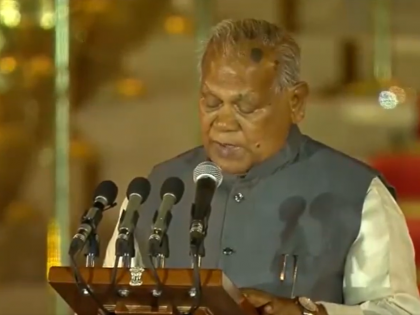Jitan Ram Manjhi Makes History: First Union Minister From Marginalised Musahar Community
By Lokmat English Desk | Updated: June 9, 2024 21:26 IST2024-06-09T21:25:25+5:302024-06-09T21:26:12+5:30
On Sunday, Jitan Ram Manjhi, the founder of Hindustan Awami Morcha (HAM) and former Chief Minister of Bihar, was ...

Jitan Ram Manjhi Makes History: First Union Minister From Marginalised Musahar Community
On Sunday, Jitan Ram Manjhi, the founder of Hindustan Awami Morcha (HAM) and former Chief Minister of Bihar, was sworn in as a Union Minister in Prime Minister Narendra Modi's cabinet. HAM, a member of the NDA in Bihar, celebrated Manjhi's ascent to this position.
#WATCH | Hindustani Awam Morcha (Secular) founder Jitan Ram Manjhi takes oath as a Union Cabinet Minister in the Prime Minister Narendra Modi-led NDA government pic.twitter.com/kpKLLf00pJ
— ANI (@ANI) June 9, 2024
Manjhi emerged victorious in the Gaya Lok Sabha constituency in Bihar, securing 494,960 votes, surpassing his nearest rival, Kumar Sarvjeet of the RJD, by a margin of 1,01,812 votes, according to the Election Commission's tally released on Tuesday.
A remarkable milestone for Manjhi transcended his ministerial oath-taking. He notably became the first Union Minister from the Musahar community, marking a significant moment of representation for his people.
What is Musahar community?
The Musahar community, also known as Rishidev, Sada, Manjhi, Banbasi, predominantly inhabits the eastern Gangetic plain and the Terai region. Historically, they have been identified with occupations such as rat-catching, a derivation suggested by the term "Musahar" itself, believed to originate from the Bhojpuri words "mūs" (rat) and "ahar" (eater).
Comprising three endogamous clans—Bhagat, Sakatiya, and Turkahia—the Musahars now primarily engage in agricultural labor, often grappling with landlessness, and occasionally resorting to rat-catching to endure periods of economic hardship. Despite being categorized as Dalits, they remain among the most marginalized communities in India.
While the 2011 Census of India estimates the Musahar population to be around 250,000 in Uttar Pradesh and Bihar each, Musahar activists contest this figure, claiming a substantially larger population of over 4,000,000 in Bihar alone. Additionally, over 230,000 Musahars reside in Nepal, facing similar socio-economic challenges as their counterparts in India.
Open in app